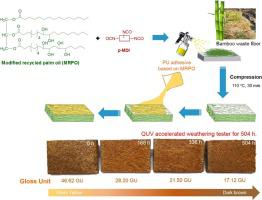当前位置:
X-MOL 学术
›
Prog. Org. Coat.
›
论文详情
Our official English website, www.x-mol.net, welcomes your
feedback! (Note: you will need to create a separate account there.)
Some properties of experimental particleboard manufactured from waste bamboo using modified recycled palm oil as adhesive
Progress in Organic Coatings ( IF 6.5 ) Pub Date : 2020-12-01 , DOI: 10.1016/j.porgcoat.2020.105899 Anutida Suwan , Nathapong Sukhawipat , Nattapon Uthaipan , Anuwat Saetung , Nitinart Saetung
Progress in Organic Coatings ( IF 6.5 ) Pub Date : 2020-12-01 , DOI: 10.1016/j.porgcoat.2020.105899 Anutida Suwan , Nathapong Sukhawipat , Nattapon Uthaipan , Anuwat Saetung , Nitinart Saetung

|
Abstract New advanced and high-performance particleboard was made from bamboo waste combined with bio-polyurethane adhesive based on recycled palm oil. The bio-polyol modified recycled palm oil (MRPO) was synthesized in a single step, by epoxidation and ring-opening reactions. The physical properties and chemical structure of MRPO polyol were studied and confirmed by FT-IR, respectively. The bio-polyurethane adhesive was then synthesized using MRPO polyol and polymeric diphenyl-methane diisocyanate (p-MDI). The gel time kinetics of the MRPO polyurethane adhesive was investigated. For the particleboard preparation, the bamboo surface fiber was treated with 5% KOH for producing particleboard. The morphology of the bamboo surface fiber after surface treatment was characterized by SEM and elemental chemistry of surface was analyzed by EDX. Increasing the adhesive content (15 to 60 %wt) and NCO index (100 to 180) increased the flexural strength, elastic modulus and water absorption resistance of the particleboard. In addition, the effect of coating on the surface of particleboard with MRPO polyurethane adhesive on mechanical properties and ultraviolet (UV) weathering resistance were studied. The coated particleboard showed higher surface gloss, less color changes, and delayed degradation from UV sunlight aging. Also, the mechanical properties and water absorption resistance of the particleboard were improved by MRPO polyurethane adhesive coating on the particleboard. The results demonstrated the benefits of using MRPO polyol in the form of a new polyurethane adhesive to produce particleboard from bamboo waste, supporting the concept of eco-friendly materials.
中文翻译:

以改性再生棕榈油为粘合剂的废竹实验刨花板的一些性能
摘要 以回收的棕榈油为原料,将竹废料与生物聚氨酯胶粘剂制成新型高性能刨花板。生物多元醇改性再生棕榈油 (MRPO) 是通过环氧化和开环反应一步合成的。MRPO多元醇的物理性质和化学结构分别通过FT-IR进行了研究和确认。然后使用 MRPO 多元醇和聚合二苯基甲烷二异氰酸酯 (p-MDI) 合成生物聚氨酯粘合剂。研究了 MRPO 聚氨酯粘合剂的凝胶时间动力学。对于刨花板的制备,竹表面纤维用 5% KOH 处理以生产刨花板。表面处理后竹表面纤维的形貌通过扫描电镜表征,表面元素化学通过 EDX 分析。增加粘合剂含量(15 至 60 %wt)和 NCO 指数(100 至 180)可提高刨花板的弯曲强度、弹性模量和吸水性。此外,还研究了用MRPO聚氨酯胶粘剂涂覆在刨花板表面对力学性能和紫外线(UV)耐候性的影响。涂层刨花板显示出更高的表面光泽度、更少的颜色变化以及因紫外线日光老化而导致的降解延迟。此外,通过在刨花板上涂上MRPO聚氨酯胶粘剂,提高了刨花板的力学性能和吸水性能。结果证明了使用新型聚氨酯粘合剂形式的 MRPO 多元醇从竹废料生产刨花板的好处,支持环保材料的概念。
更新日期:2020-12-01
中文翻译:

以改性再生棕榈油为粘合剂的废竹实验刨花板的一些性能
摘要 以回收的棕榈油为原料,将竹废料与生物聚氨酯胶粘剂制成新型高性能刨花板。生物多元醇改性再生棕榈油 (MRPO) 是通过环氧化和开环反应一步合成的。MRPO多元醇的物理性质和化学结构分别通过FT-IR进行了研究和确认。然后使用 MRPO 多元醇和聚合二苯基甲烷二异氰酸酯 (p-MDI) 合成生物聚氨酯粘合剂。研究了 MRPO 聚氨酯粘合剂的凝胶时间动力学。对于刨花板的制备,竹表面纤维用 5% KOH 处理以生产刨花板。表面处理后竹表面纤维的形貌通过扫描电镜表征,表面元素化学通过 EDX 分析。增加粘合剂含量(15 至 60 %wt)和 NCO 指数(100 至 180)可提高刨花板的弯曲强度、弹性模量和吸水性。此外,还研究了用MRPO聚氨酯胶粘剂涂覆在刨花板表面对力学性能和紫外线(UV)耐候性的影响。涂层刨花板显示出更高的表面光泽度、更少的颜色变化以及因紫外线日光老化而导致的降解延迟。此外,通过在刨花板上涂上MRPO聚氨酯胶粘剂,提高了刨花板的力学性能和吸水性能。结果证明了使用新型聚氨酯粘合剂形式的 MRPO 多元醇从竹废料生产刨花板的好处,支持环保材料的概念。











































 京公网安备 11010802027423号
京公网安备 11010802027423号